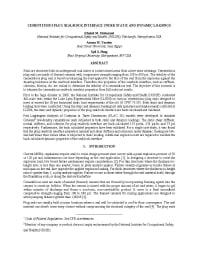Mining Publication: Cementitious Plug Seal/Rock Interface Under Static and Dynamic Loadings
Original creation date: October 2009
Authors: KM Mohamed, AM Yassien, SS Peng
NIOSHTIC2 Number: 20037615
Proceedings of the 80th Shock and Vibration Symposium (DoD), San Diego, California, October 25-29, 2009. Arvonia, VA: The Shock & Vibration Information Analysis Center, 2009; :1-14
Seals are structures built in underground coal mines to isolate mined areas from active mine workings. Cementitious plug seals are made of foamed cements with compressive strength ranging from 100 to 600 psi. The stability of the cementitious plug seal is based on balancing the load applied to the face of the seal from the explosion against the shearing resistance at the seal/rock interface. Therefore, the properties of the seal/rock interface, such as stiffness, cohesion, friction, etc. are critical to determine the stability of a cementitious seal. The objective of this research is to estimate the cementitious seal/rock interface properties from full scale test results. Prior to the Sago disaster in 2006, the National Institute for Occupational Safety and Health (NIOSH) conducted full-scale tests within the Lake Lynn Experimental Mine (LLEM) on various cementitious plug seals designed to meet or exceed the 20-psi horizontal static load requirements of the old 30 CFR 75.335. Both static and dynamic loading tests were conducted. Using the static and dynamic loading test data (pressure and displacement) collected at LLEM, the static and dynamic properties of the plug seal/rock interface are back calculated and validated. Fast Lagrangian Analysis of Continua in Three Dimensions (FLAC 3D) models were developed to simulate Celuseal low-density cementitious seals subjected to both static and dynamic loadings. The static shear stiffness, normal stiffness, and cohesion for plug seal/rock interface are back calculated 115 psi/in, 230 psi/in, and 75 psi respectively. Furthermore, the back calculated properties have been validated. For a single case study, it was found that the plug seal/rock interface properties (normal and shear stiffness and cohesion) under dynamic loading are two-and- half times their values when it subjected to static loading. Additional explosion tests are required to validate the back calculated dynamic properties of the seal/rock interface.

NIOSHTIC2 Number: 20037615
Proceedings of the 80th Shock and Vibration Symposium (DoD), San Diego, California, October 25-29, 2009. Arvonia, VA: The Shock & Vibration Information Analysis Center, 2009; :1-14
- Clearing the Air
- Comparison of Methods: Dynamic Versus Hydrostatic Testing of Mine Ventilation Seals
- Explosion Pressure Design Criteria for New Seals in U.S. Coal Mines
- Inflatable Partitions for High-Expansion Foam Generators
- Progress Toward Improved Engineering of Seals and Sealed Areas of Coal Mines
- Shear Strength Evaluation of Clay-Rock Mixtures
- Strength Characteristics and Air-Leakage Determinations for Alternative Mine Seal Designs
- Strengthening Existing 20-psi Mine Ventilation Seals With Carbon Fiber-Reinforced Polymer Reinforcement
- Use of Ground Penetrating Radar and Schmidt Hammer Tests to Determine the Structural Integrity of a Mine Seal
- Use of Pressure Swing Adsorption Technology to Inert Sealed Mine Areas with Nitrogen